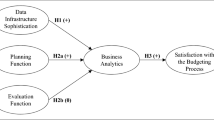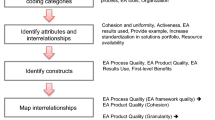Abstract
Business performance modeling and model-driven business transformation are two research directions that are attracting much attention lately. In this study, we propose an approach for dashboard development that is model-driven and can be integrated with the business performance models. We adopt the business performance modeling framework, and we extend it in order to capture the reporting aspect of the business operation. We describe models that can effectively represent all the elements necessary for the business performance reporting process, and the interactions among them. We demonstrate how all these models can be combined and automatically generate the final solution. We further extend the proposed framework with mechanisms that can detect changes in the models and incrementally update the deployed solutions. Finally, we discuss our experience from the application of our technique in a real-world scenario. This case study shows that our technique can be efficiently applied to and handle changes in the underlying business models, delivering significant benefits in terms of both development time and flexibility.
Similar content being viewed by others
References
Bhattacharya, K., Guttman, R., Lyman, K., Heath, I. F. F., Kumaran, S., & Nandi, P., et al. (2005). A model-driven approach to industrializing discovery processes in pharmaceutial research. IBM Systems Journal, 44(1), 145–162.
Chen, S.-K., Lei, H., Wahler, M., Chang, H., Bhaskaran, K., & Frank, J. (2006). A model driven XML transformation framework for business performance management model creation. IJEB, 4, 281–307.
Chowdhary, P., An, L., Jeng, J.-J., & Chen, S.-K. (2005). Enterprise integration and monitoring solution using active shared space. In ICEBE (pp. 295–304).
Czarnecki, K., & Helsen, S. (2003). Classification of model transformation approaches. In OOPSLA workshop on generative techniques in the context of model-driven architecture, Anaheim, CA.
Frakes, W. B., & Kang, K. (2005). Software reuse research: Status and future. IEEE Transactions on Software Engineering, 31(7), 529–536.
Gray, J., Bosworth, A., Layman, A., & Pirahesh, H. (1996). Data cube: A relational aggregation operator generalizing group-by, Cross-Tab, and Sub-Total. ICDE.
Greenfield, J., Short, K., Cook, S., & Kent, S. (2003). Software factories assembling applications with patterns, models, frameworks and tools. In 18th annual ACM OOPSLA.
Jeng, J. J., Buckley, S., Chang, H., Chung, J. Y., Kapoor, S., & Kearney, J., et al. (2002). BAM: An adaptive platform for managing business process solutions. ICECR.
Jeng, J. J., Schiefer, J., & Chang, H. (2003). An agent-based architecture for analyzing business processes of real-time enterprises. In EDOC (pp. 86–97). Washington, DC: IEEE Computer Society.
Kleppe, A., Warmer, J., & Bast, W. (2003). MDA explained, the model driven architecture: Practice and promise. Reading, MA: Addison-Wesley.
Koehler, J., Tirenni, G., & Kumaran, S. (2002). From business process model to consistent implementation: A case for formal verification methods. In EDOC (pp. 96–106). Washington, DC: IEEE Computer Society.
Kumaran, S. (2004). Model-driven enterprise. In Proceedings of global enterprise architecture integration summit (pp. 166–180).
Kumaran, S., & Nandi, P. (2005). Adaptive business objects: A new component model for business integration. In Proceedings of ICEIS (pp. 48–58).
Marian, A., Abiteboul, S., Cobena, G., & Mignet, L. (2001). Change-centric management of versions in an XML warehouse. In VLDB (pp. 581–590). San Francisco, CA: Morgan Kaufmann.
McGowan, C., & Bohmer, L. (1993). Model-based business process improvement. ICSE.
Miller, J., & Mukerji, J. (Eds.) (2003). MDA guide version 1.0.1. Object management group. Retrieved from http://www.omg.org/docs/omg/03-06-01.pdf.
Mumick, I. S., Quass, D., & Mumick, B. S. (1997). Maintenance of data cubes and summary tables in a warehouse. SIGMOD.
Myers, B., Hudson, S. E., & Pausch, R. (2000). Past, present, and future of user interface software tools. In ACM ToCHI, vol. 7 (pp. 3–28). New York: ACM Press.
Palpanas, T., Sidle, R., Cochrane, R., & Pirahesh, H. (2002). Incremental maintenance for non-distributive aggregate functions. In VLDB (pp. 802–813).
Rugaber, S., & Stirewalt, K. (2004). Model-driven reverse engineering. IEEE Software, 21(4), 45–53.
Sukaviriya, N., Kumaran, S., Nandi, P., & Heath, T. (2005). Integrate model-driven UI with business transformations. MDDAUI.
van der Aalst, W. M. P., ter Hofstede, A. H. M., & Weske, M. (2003). Business process management: A survey. Eindhoven, The Netherlands: BPM.
Yu, Y., Wang, Y., Mylopoulos, J., Liaskos, S., Lapouchnian, A., & Sampaio do Prado Leite, J. C. (2005). Reverse engineering goal models from legacy code. In ICRE (pp. 363–372). Los Alamitos, CA: IEEE Computer Society Press.
Zeng, L., Lei, H., Dikun, M., Chang, H., Bhaskaran, K., & Frank, J. (2005). Model-driven business performance management. In ICEBE (pp. 295–304).
Author information
Authors and Affiliations
Corresponding author
Additional information
Work done while Palpanas was a member of the IBM T.J. Watson research Center.
Rights and permissions
About this article
Cite this article
Palpanas, T., Chowdhary, P., Mihaila, G. et al. Integrated model-driven dashboard development. Inf Syst Front 9, 195–208 (2007). https://doi.org/10.1007/s10796-007-9032-9
Published:
Issue Date:
DOI: https://doi.org/10.1007/s10796-007-9032-9




